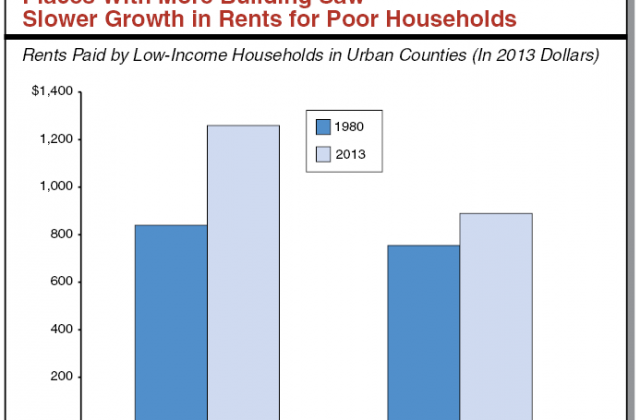California Study: More Private Development Means Lower Rents
It’s red herring week here at Smart Growth Seattle and today we put the “building new market housing causes displacement” and “inclusionary zoning helps that problem” red herrings in the compost bin. The headline of the blog post summing up a California Legislative Analyst Office (LAO) study says it all: Want to Slow Displacement? Then Build More Housing. Now if you’ve been paying attention, you’ll know that there is no good quantitative definition of displacement, which is more about how people feel about moving or having to move. The LAO report gives about the best quantitative shot as I’ve seen to figure out what displacement means.
Defining Displacement. Researchers have not developed a single definition of displacement. Different studies use different measures. For our analysis, we use a straightforward yet imperfect definition of displacement which is similar to the definition used by UC Berkeley researchers. Specifically, we define a census tract as having experienced displacement if (1) its overall population increased and its population of low–income households decreased or (2) its overall population decreased and its low–income population declined faster than the overall population.
I won’t spend a lot of time on why this definition fails as well, but clearly we wouldn’t know or be able to account for exactly why the household mix changed. Perhaps the low-income households started to earn more money. Maybe the construction of new housing resulted in the sale of existing low-income buildings causing some low-income households to move; but where did they go? Are they better off now than they were in that census tract? More importantly, how do they feel about the move?
I’m just going to post the second most satisfying paragraph in the report.
More Private Development Associated With Less Displacement. As market–rate housing construction tends to slow the growth in prices and rents, it can make it easier for low–incomehouseholds to afford their existing homes. This can help to lessen the displacement of low–income households. Our analysis of low–income neighborhoods in the Bay Area suggests a link between increased construction of market–rate housing and reduced displacement. (See the technical appendix for more information on how we defined displacement for this analysis.) Between 2000 and 2013, low–income census tracts (tracts with an above–average concentration of low–income households) in the Bay Area that built the most market–rate housing experienced considerably less displacement. As Figure 3 shows, displacement was more than twice as likely in low–income census tracts with little market–rate housing construction (bottom fifth of all tracts) than in low–income census tracts with high construction levels (top fifth of all tracts).
Again, I don’t really think we’ll ever get a measure of displacement, but this definition is as good as it gets and certainly exceeds the feeble efforts we’ve seen locally by the City and others. And the verdict is that the more private development happens the better off lower income people are.
And what’s the most satisfying conclusion of the report?
Results Do Not Appear to Be Driven by Inclusionary Housing Policies. One possible explanation for this finding could be that many Bay Area communities have inclusionary housing policies. In communities with inclusionary housing policies, most new market–rate construction is paired with construction of new affordable housing. It is possible that the new affordable housing units associated with increased market–rate development—and not market–rate development itself—could be mitigating displacement. Our analysis, however, finds that market–rate housing construction appears to be associated with less displacement regardless of a community’s inclusionary housing policies. As with other Bay Area communities, in communities without inclusionary housing policies, displacement was more than twice as likely in low–income census tracts with limited market–rate housing construction than in low–income census tracts with high construction levels.
There you have it. More building actually does benefit lower income households and reduces displacement. And the terrible, punitive, and inflationary policy of Mandatory Inclusionary Zoning (MIZ) doesn’t positively impact displacement; just let people build more housing!
Not enough?
Relationship Remains After Accounting for Economic and Demographic Factors. Other factors play a role in determining which neighborhoods experience displacement. A neighborhood’s demographics and housing characteristics probably are important. Nonetheless, we continue to find that increased market–rate housing construction is linked to reduced displacement after using common statistical techniques to account for these factors.
The completely ham handed efforts of Councilmembers Mike O’Brien and Lisa Herbold to basically make it harder to build housing in poorer neighborhoods with more people of color is going to make things worse, not better for poor people. Too bad that the Seattle City Council and Mayor and supporters of MIZ are impervious to the facts. California is in the midst of the disaster that we’re imposing on ourselves, reduced supply, higher costs, and higher prices for people who need housing.




